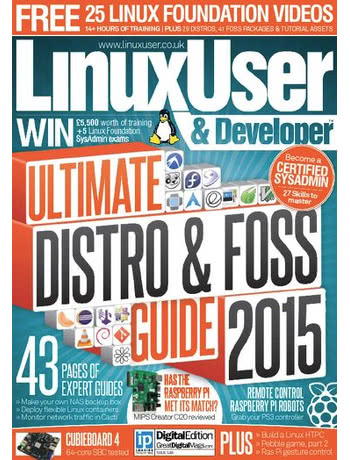
Looking at the guide first, it’s a natural follow-on to the work I’ve done in years past for the magazine. Each year, a multi-page round-up of the ‘best’ Linux distributions is published; this year, deputy editor Gavin Thomas asked for something a little different. The result: a write-up of picks for ‘best’ distribution in a variety of categories, but also covering free and open-source software (FOSS) packages which can be installed in any distribution to extend its capabilities in a given category.
Some of the feature was written in-house by the magazine’s staff writers, but I was given four categories relevant to my expertise: Linux for developers, for enterprises, for security professionals, and for those looking for a distribution with rolling-release development methodology. In each case, a top pick was selected along with three alternatives. Five FOSS packages relating to the category were also highlighted, except in the rolling-release section where instead I highlighted five general-purpose FOSS packages which have received my personal seal of approval.
My review of the CubieBoard 4 from low-power computing specialist New IT takes the perspective of a Linux-confident user, as is usual for the magazine. As a result, some of the software-related disadvantages I highlighted in my review of the same hardware for Custom PC don’t apply – although it’s still fair to say that CubieTech should spend a little more time on polishing the sharp edges of its software releases before it brings out yet another new product.
For those unfamiliar, the big selling point of the CubieBoard 4 is that it packs eight ARM-based processing cores into a low-power fanless design. Using ARM’s big.LITTLE design paradigm, four are high-performance cores while four are low-power cores. Unlike its rivals, however, the CubieBoard 4’s AllWinner A80 chip provides the host OS with access to all eight cores simultaneously – making for a seriously powerful machine for multi-threaded use. While heat builds up quickly if you’re thrashing all eight cores, it’s one of the most powerful SBCs I’ve tested besting even the £199.99 Nvidia Jetson TK1 on CPU-bound multi-threaded tasks.
All this, plus my regular four-page look at upcoming events and everything interesting in the open source, open hardware, open governance and anything-else-open-I-think-of world, is available now at your local newsagent or digitally via Zinio and similar services. As always, my content will be republished translated into French in the coming months as part of Inside Linux Magazine.
UPDATE 20150130:
Since writing the CubieBoard 4 review, which was based on the v1.1 hardware revision, CubieTech has modified the board and released v1.2. New IT has kindly sent out an updated model, and there are numerous changes for the better: the Wi-Fi antenna no longer pushes up against a case bolt, the glue-on heatsink has been swapped out for a push-pin version with a tube of thermal interface material (TIM) and an air-gap between the fins and the top of the case, and the case itself has been revised to accommodate the push-pins. The GPIO header also now comes with a pin mapping table silk-screened directly onto the PCB for quick reference. While none of these improvements are dramatic enough to alter the overall score, they’re certainly welcomed.


 In this month’s Linux User & Developer Magazine, I take a look at two devices from the world of single-board computers – just for a change. The first is the Wolfson Audio Card, an add-on for the Raspberry Pi that promises to boost its sound capabilities considerably; the second, a quad-core Freescale i.MX6-based machine that tries its hardest to be an open-source set-top box. Plus, as usual, there’s my usual four-page news spread to enjoy.
In this month’s Linux User & Developer Magazine, I take a look at two devices from the world of single-board computers – just for a change. The first is the Wolfson Audio Card, an add-on for the Raspberry Pi that promises to boost its sound capabilities considerably; the second, a quad-core Freescale i.MX6-based machine that tries its hardest to be an open-source set-top box. Plus, as usual, there’s my usual four-page news spread to enjoy.
